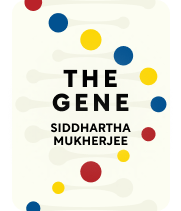

This article is an excerpt from the Shortform book guide to "The Gene" by Siddhartha Mukherjee. Shortform has the world's best summaries and analyses of books you should be reading.
Like this article? Sign up for a free trial here.
What is Siddhartha Mukherjee’s The Gene: An Intimate History about? What have we learned about genetics?
The book The Gene: An Intimate History explores scientists’ efforts to learn about people by studying the genes that create us. The book traces the history of genetics from Darwin’s Origin of Species to modern gene sequencing technology, as well as taking a brief look at what genetic engineering might mean for humanity’s future.
Here’s a brief overview of The Gene: An Intimate History by Siddhartha Mukherjee.
The Gene: An Intimate History
Scientists have known for centuries that biological traits get passed from one generation to the next, but it was only recently—with a great deal of trial and error, and several technological advancements—that they learned exactly how that happens. The Gene: An Intimate History explores key moments in the ongoing study of genetics, with a particular focus on the people behind those moments.
Every part of our bodies, from toenails to hair and everything in between, is built based on the instructions coded into our genes. Therefore, understanding what genes are and how they work is crucial to understanding our bodies, our health, and even our identities (after all, our brains are also built from those genetic instructions). Siddhartha Mukherjee wrote The Gene to give the average reader a basic grounding in the history and the science of genetics, to better understand what we know about ourselves and how we know it.
Mukherjee is an immunologist and geneticist known for his work in the field of cancer research, a field closely linked to genetics. The Gene: An Intimate History is Mukherjee’s second book, published after The Emperor of All Maladies, an in-depth study of the history of cancer research. The Emperor of All Maladies was published in late 2010 and won the 2011 Pulitzer Prize for General Non-Fiction.
Our commentary will provide background information and explanations to help readers understand the science behind The Gene. We’ll also examine advancements in genetics since The Gene’s publication in 2016.
Part 1: Discovering the Gene
Danish botanist Wilhelm Johannsen coined the word “gene” in 1909, but Mukherjee starts The Gene by talking about three scientists who made crucial strides in the field of genetics before that term even existed: Charles Darwin, Gregor Mendel, and Hugo de Vries.
We’ll begin this guide by discussing the groundwork of genetics those three men laid. Then we’ll discuss what genes are, how they work, and how scientists have learned to understand and manipulate genetic information. We’ll also talk briefly about how our genes impact our personal identities. Finally, we’ll end with Mukherjee’s ideas about the future of genetics, as well as the legal and ethical challenges the field currently faces.
Darwin’s Theory of Evolution
Mukherjee begins the story of genetics in 1859, when Charles Darwin published his theory of evolution, titled On the Origin of Species by Means of Natural Selection (commonly shortened to The Origin of Species). Darwin developed his theory by studying finches in the Galapagos Islands, where he found that birds on different islands had distinctly different beak shapes—for example, one beak type was well suited for cracking open nuts, while another was effective at digging insects out of tree bark.
Darwin concluded that each type of finch had evolved to thrive in its particular environment. This happened because traits that help organisms survive and reproduce tend to get passed on to the next generation, while less suitable traits tend to get outcompeted and die out. In this case, because the conditions on each island were slightly different, over time those traits diverged and created noticeably different types of finches.
However, Mukherjee tells us that while Darwin accurately explained the results of evolution, he wasn’t able to figure out how it worked. Darwin (incorrectly) proposed small “particles” of inheritance produced by cells and carried in the blood, which he called gemmules.
Darwin theorized that streams of these particles from each parent would mingle in their offspring, thereby blending the parents’ traits. He called this theory pangenesis (meaning “originating from everything”) to illustrate that any given gemmule could come from anywhere in the body.
He also believed that, because any cell could produce gemmules, those gemmules would carry information about changes that cell had undergone—for instance, injuries, or muscles made stronger through a lifetime of exercise. In other words, pangenesis theory relied in part on the inheritance of acquired characteristics, rather than purely genetic ones.
(Shortform note: Some modern scientists think pangenesis theory may be more accurate than previously thought. Some studies have shown that certain experiences—especially traumatic ones—leave genetic markers that can be passed on to offspring. For example, an animal might instinctively be afraid of the scent of a predator, even if it’s never smelled that predator before and therefore shouldn’t know what it is. Furthermore, some scientists report finding free-floating genetic material in the blood, which would be a perfect match for Darwin’s gemmules. However, this theory is still controversial and unpopular in the scientific community.)
Mendel’s “Unit of Heredity”
In 1864, not long after Darwin published The Origin of Species, biologist and Augustinian friar Gregor Mendel made another major breakthrough in genetics (although that word didn’t exist yet). By breeding and studying pea plants with obviously different traits—such as different heights, different colored flowers, and so on—he discovered clear patterns of inheritance across generations.
Most importantly, according to Mukherjee, Mendel discovered that traits would be passed on completely; for example, if he cross-pollinated a purple-flowered plant with a white-flowered plant, the offspring would have purple flowers. This ran counter to the popular theory of Mendel’s time that traits would “blend” during inheritance, in which case that plant would end up with pale purple flowers, or some purple and some white.
If traits get passed on completely intact, Mendel reasoned, then there must be a “unit” of heredity: self-contained packets of genetic information representing a single trait—which Mendel called factors—rather than a stream of particles mixing with other streams like Darwin proposed.
De Vries Fills in the Gaps
Mukherjee recounts that in the 1890s, Dutch botanist Hugo de Vries made the next major step toward modern genetics by recognizing that a self-contained unit of heredity perfectly explained Darwin’s observations of how species evolve. In other words, Mendel and Darwin’s discoveries were both parts of a single, cohesive theory of evolution.
De Vries added one point of his own to this theory: There must be a chance, however small, that genetic information could spontaneously change during reproduction. In other words, de Vries introduced the concept of mutations.
Mutations are a critical part of evolutionary theory because evolution requires diversity—natural selection can’t “select” genes that don’t exist—and without mutations, there would be no way for new traits to appear. For example, Darwin’s finches couldn’t have developed different types of beaks unless there were already slight beak differences coded into their genes.
Part 2: Chromosomes and DNA
With the foundation of genetics established, Mukherjee moves on to explain how we learned about the biological mechanisms behind inheritance. Namely, he discusses the structures inside of cells that carry genes—called chromosomes—and the actual genetic code found in DNA.
In the early 1910s, geneticist Thomas Morgan bred thousands of fruit flies to study inheritance patterns. He looked for visible traits such as eye color and wing shape, then traced them through numerous generations of fruit flies. Through his observations, Morgan made two crucial discoveries about genes.
The first was what he termed linkage: Morgan noticed that, contrary to Mendel’s Law of Independent Assortment, certain traits were almost always inherited together. He correctly concluded that the genes controlling those traits were somehow physically linked together.
(Shortform note: Specifically, genes are considered linked when they consistently appear together over three or more generations. The odds of the same genes appearing together by chance in almost every individual across three generations is nearly zero, so that benchmark allows geneticists to say that genes are linked with a high degree of certainty.)
One of Morgan’s student assistants, Alfred Sturtevant, later elaborated on that discovery, noting that how frequently genes are inherited together directly correlates with how close together they are on the chromosome. In other words, two genes that are very close to each other will almost always be inherited together, while genes that are far apart have no more than a 50/50 chance of appearing together.
Sturtevant began plotting fruit fly chromosomes based on this discovery, which was the beginning of the field we now call gene mapping.
(Shortform note: Today, a sturt—named in honor of Alfred Sturtevant’s work with gene mapping—is a unit of distance used for chromosomes. One sturt is the distance that results in a 1% difference in the chance that two genes will be inherited together.)
Morgan also discovered a phenomenon that he called crossing over: Once in a while, closely linked traits will not be inherited together, suggesting that genes can somehow change position or swap places. He determined that it happened because pairs of chromosomes—one copy of a chromosome from the mother and one from the father—can exchange genes with each other to create new combinations of traits. This process is very unlikely to separate closely linked genes, but it can happen.
(Shortform note: Crossing over (which, as we mentioned earlier, occurs during sexual reproduction) is a key source of genetic diversity. That genetic diversity, which leads to a greater number of trait combinations in the next generation—and therefore more chances for natural selection to work—is one of the reasons why nature generally favors sexual reproduction in complex species like humans.)
Genes Are Made of DNA
Scientists were beginning to understand where genes can be found, how they’re arranged, and why that matters. However, geneticists still had no idea how genes actually work, or even what they’re made of.
Mukherjee tells us that, ironically, scientists discovered nucleic acids (DNA and RNA) in the 1920s, but they decided that nucleic acids were much too simple to carry genetic information. Therefore, they dismissed those molecules in favor of studying proteins, which were more complex, and (in Mukherjee’s words) more interesting.
Thanks to their relatively simple structures, nucleic acids would remain largely unappreciated until the 1940s, when molecular biologists Oswald Avery, Colin MacLeod, and Maclin McCarty demonstrated that DNA, not proteins, carries genetic information. Oswald published their findings in 1944.
After scientists learned what DNA is, Mukherjee says that the next question was, naturally, what it does. In other words, what does it actually mean that DNA “carries genetic information?”
Biologists George Beadle and Edward Tatum discovered the answer in 1945: DNA contains instructions for building the proteins that make up just about everything in our bodies. So, in a very real sense, our genes contain the blueprints for our bodies.
DNA’s Four Nucleotides
DNA itself is made of four base chemicals called nucleotides: adenine (A), cytosine (C), guanine (G), and thymine (T). Mukherjee tells us that all genes, regardless of species, consist of those four nucleotides in various combinations. Nucleotides have two key binding sites that make them perfect for creating chains of DNA: One site at the “bottom” of the molecule where the next nucleotide attaches itself, and one that binds to the other DNA chain of the double helix.
(Shortform note: Some virus genomes are made of RNA, not DNA, a fact that Mukherjee himself puts in a footnote much later in The Gene. However, DNA is a more stable molecule than RNA, and it’s easier to repair in case of damage. That’s why nearly all life on Earth has evolved with DNA. In theory, there could be complex multicellular organisms with RNA genomes, but so far, no such species has been discovered.)
In 1953, molecular biologists James Watson and Francis Crick—using data from another scientist named Rosalind Franklin, who went uncredited in their paper—developed the first accurate model of DNA, the now-famous “double helix” model.
While creating that model, Watson also discovered that the four nucleotide bases are actually two pairs: T is always linked to A, and C is always linked to G. That happens because those nucleotide pairs chemically bond to one another and thereby hold the DNA molecule together.
Genes Switch On and Off
After researchers discovered how DNA encodes the information that determines how an organism will develop, it wasn’t long before they identified exactly how these genes function in real time.
Every cell in an organism’s body contains a set of that organism’s genes; in fact, each of its cells has identical DNA. This is logical, since every organism starts out as a single cell (a fertilized egg) which then replicates itself countless times. However, that seems to imply that all of its cells should be the same, which clearly isn’t the case. One cell becoming skin while another becomes bone or brain tissue is a matter of activating and deactivating certain genes at certain times.
To illustrate the point, Ed Lewis—a geneticist working with fruit flies in the 1950s—discovered that some rare mutations would lead to flies having wildly different body structures, such as a leg growing out of the head. He concluded that there must be genes regulating when and how other genes are expressed, which he called effectors. Errors in those effectors led to the mutations he was observing: For example, one such mistake might activate the “grow antenna” genes in cells on the fly’s thorax.
How Genes Create Proteins
The process in which DNA creates functional proteins is intricate and involves many different enzymes (proteins that aid chemical reactions). However, Mukherjee describes the process in two broad steps:
1. Transcription. Enzymes read the DNA “blueprint” and create a matching RNA molecule of the genes to be translated into proteins.
(Shortform note: This step is crucial because only a small part of your genome gets transcribed into RNA at a time. If your cells read your DNA directly and made proteins based on that, they could end up trying to create an entire genome’s worth of proteins at once.)
2. Translation. Other enzymes read instructions encoded in the RNA molecule, retrieve the needed amino acids (simple organic compounds that make up proteins) from the blood, and assemble them into proteins.
(Shortform note: There are a total of 20 amino acids that, when put together in various combinations and shapes, create countless proteins. Of those 20, nine are considered essential amino acids because our bodies can’t produce them. In other words, they’re essential parts of our diet, because the only way we can get those amino acids is by breaking down proteins from other organisms that produce them. Perhaps the best-known essential amino acid is tryptophan, which is found in turkey (among other sources), and is supposedly responsible for the post-Thanksgiving drowsiness many people experience.)
Parts 3 and 4: Writing and Reading Genes
Scientists had discovered that the language of biology is encoded in DNA, and it consists of only four letters. The next step for geneticists was to figure out how to read and write in that language.
Editing Genomes
Mukherjee tells us that, in 1970, Stanford biochemists Paul Berg and David Jackson successfully created recombinant DNA—DNA containing genes from multiple different sources—by inserting the genome of a virus called SV40 into the DNA of a bacteriophage (a type of virus that infects bacteria).
Combining the genomes of two species was an exceptional feat in itself, but it also hinted at a way to quickly and efficiently create drugs such as insulin and certain antibiotics—substances that are normally produced inside of living organisms. For example, inserting an insulin-creating gene into a virus’s genome and allowing that virus to replicate would naturally mean that the insulin gene gets replicated as well. In other words, by editing viruses’ genomes, scientists could turn them into microscopic medicine factories.
(Shortform note: Today, recombinant DNA technology has many uses even outside of medicine, particularly in agriculture. Most notably, by altering plant genomes, scientists can create crops that resist diseases, require less water or less fertilizer, and have greater yields than their unaltered counterparts.)
Reading Genes With Gene Sequencing
As we’ve said, it isn’t nucleotides themselves that encode genetic information—four chemicals aren’t nearly enough to account for the enormous array of proteins that our bodies produce—but rather the order in which those nucleotides are arranged. Therefore, Mukherjee tells us that in order to decode genetic instructions, scientists first had to learn how to sequence genes—in other words, to determine exactly which nucleotides are present and in what order.
In 1977, Cambridge biochemist Frederick Sanger fully sequenced a genome for the first time. Using specially tagged nucleotides, he was able to follow along as the virus replicated itself, painstakingly copying down the approximately 5,400 base pairs of a virus called Phi X174. By doing so, he was able to match genes with the proteins they created—in essence, he learned how to read the virus’s genetic code.
Intergenic DNA and Introns: Genetic “Filler”
Mukherjee adds that, as scientists continued sequencing genomes of different species, they found something very odd: Animal genomes contain long stretches of DNA that don’t actually code for proteins. These noncoding zones can be found both between genes (where they’re called intergenic DNA) and within genes (called introns).
In fact, in humans, a full 98% of our genome doesn’t code for anything. Mukherjee says that even geneticists aren’t sure why that is, and he explains the three competing theories:
- The noncoding DNA regulates genes—the extra space helps control when they’re activated and deactivated.
- The noncoding DNA serves some other purpose that we haven’t yet discovered.
- The noncoding DNA is genetic junk left over from millions of years of evolution, and it serves no purpose at all.
(Shortform note: Contrary to what Mukherjee writes here, scientists do know at least one purpose of introns: Noncoding sections of DNA get removed from the transcribed genetic instructions, effectively breaking up genetic “sentences” into individual “words.” This is significant because it allows for alternative splicing—essentially, rearranging the remaining pieces into different combinations. This process allows a single gene to code for multiple different proteins.)
Gene Sequencing in Medicine
Mukherjee says that nowadays, improved gene sequencing technology allows doctors and researchers to find and diagnose genetic diseases.
A doctor of internal medicine named Victor McKusick led the charge to bring genetics to medicine. He first became interested in genes in 1947, when he found that a certain disease (now called Peutz-Jeghers syndrome) ran in families and concluded that it must be the result of a defective gene.
By 1998, McKusick had discovered some 12,000 disease-causing gene variants. He’d also found that some disorders are the result of a single mutation—such as sickle-cell anemia—while others are much more complex. For example, Down’s syndrome is the result of someone inheriting an entire extra chromosome, while conditions like cancer and heart disease can be influenced (though not directly caused) by numerous different genes.
In many cases, gene sequencing techniques even allow doctors to diagnose diseases and disorders in utero, allowing the mother to make informed decisions about whether to proceed with the pregnancy. The first such case occurred in 1968, when a woman known only as J.G. decided to terminate her pregnancy rather than give birth to a child who was likely to live a very short and painful life.
The Human Genome Project
In 1989, a group of biologists began the massive undertaking of sequencing the entire human genome. A council of 12 advisers, chaired by American geneticist Norton Zinder, led the effort.
Mukherjee tells us that the human genome contains over three billion base pairs—for a sense of scale, remember that the first fully sequenced genome was a virus consisting of about 5,400 base pairs. Completing the project would take an estimated 50,000 person-years and cost three billion dollars—about a dollar per base pair.
However, in spite of its massive scope, the Human Genome Project (HGP) released a first draft of the complete human genome just over a decade later, in 2000. Then, in 2003, the HGP’s chair officially declared it complete: Every human gene had been accurately sequenced and mapped. The Project uploaded its final results to the internet, where the genome map is still publicly available today.
However, Mukherjee says that even with all of this understanding of human genetics—where every gene is, what it codes for, and how—we still understand very little about how all these different genes coordinate and cooperate to build and maintain our bodies. In other words, Mukherjee believes that the next step for scientists should be a deeper study of human genomics: in other words, how the genome as a whole works.
Part 5: Genetics and Identity
We’ve now had a brief overview of the history of the gene up to the present day. The remainder of this guide will focus on the current state of genetics, how genes impact us personally, and what the future might hold for both the field of genetics and the human race.
As we’ve said, our genes contain the blueprints for our bodies. Therefore, in a very real sense, our genes determine who we are. According to Mukherjee, each of us has crucial elements of who we’ll become—our ability to learn, to use language, and even our physical appearance—encoded in our DNA.
Our Genetic Identities Are Very Similar
Mukherjee says that genetically speaking, humans are all much more similar than we are different. People who believe in significant differences between “races”—for instance, that people of Asian descent are naturally good at math, or that those of African descent are more athletic—are mistaken; there simply isn’t enough genetic variation to account for such differences.
Mukherjee adds that every human alive today can trace his or her lineage down the maternal line to one woman who lived in Africa about 200,000 years ago. The fact that we have a common ancestor, especially such a recent one (by evolutionary standards), also suggests that we’re much more alike than people think.
Furthermore, scientists now believe that the first humans left Africa less than 100,000 years ago. Mukherjee tells us that it would take several times that long, at least, for any significant genetic differences to arise—in other words, for us to split into different “races.”
(Shortform note: If we all came from a common ancestor, and are still almost genetically identical as Mukherjee states, how do we explain the differences that do exist between ethnicities? The most obvious difference between “races” is skin color, which has changed more quickly than other traits because of natural selection. Populations that live near the Earth’s equator tend to have darker skin because it protects them from the intense sun and UV rays. Conversely, people who live far from the Earth’s equator—especially people in the northern hemisphere—tend to have pale skin so they can more efficiently absorb energy from the limited amount of sunlight they get.)
Genetic Differences Between Individuals
While Mukherjee is correct that there’s not much genetic variation between races (so to speak), there can be a great deal of genetic variation between individuals.
The most obvious example of genetic differences between individuals is biological sex (male versus female). This is most commonly explained as a difference of a chromosome—females have matching XX chromosomes, while males have one X and one smaller Y chromosome—but Mukherjee says the difference is even smaller than that.
Mukherjee says that in 1989, a geneticist named Peter Goodfellow narrowed “maleness” to a single gene on the Y chromosome, simply called SRY. To test his theory, Goodfellow genetically altered female mice to carry a copy of the SRY gene. Some of the offspring, though chromosomally female (XX chromosomes) seemed male in both anatomy and behavior. In other words, by altering a single gene, Goodfellow completely changed the identities of those mice.
This is just one example of how our genetics play a role in who we are.
(Shortform note: While a single gene may explain both sex and behavior in mice, humans are quite a bit more complex. Scientists have, to date, identified 19 separate genes that help determine the masculinity or femininity of the human brain—in other words, whether that person will “feel like” and identify as a man, a woman, or neither. When a person’s brain and biological sex don’t match, it can result in a condition called gender dysphoria, where the person feels trapped in the wrong body.)
Environment Plays a Large Role in Identity
Very few traits are purely genetic because most of them are also influenced by the environment. For example, identical twins (who, by definition, have all the same genes) could look and act very differently if one becomes a professional athlete while the other becomes an office worker.
Also, Mukherjee says that genes often create tendencies or predispositions toward certain kinds of behavior, but those behaviors still won’t appear unless the environment draws them out. For example, someone who’s genetically predisposed to alcoholism could go his or her entire life without ever drinking, and therefore without becoming addicted to alcohol.
The Environment Permanently Changes Our Genes
We’ve said before that genes switch on and off as you grow from a single cell into an infant, and that’s why you have so many different types of cells even though they all have the same DNA. However, genes also switch on and off throughout our lives in response to environmental factors. For example, when you’re exercising, your body will activate genes that burn extra nutrients in order to boost your energy.
Even more interestingly, Mukherjee says that those repeated activations and deactivations leave permanent marks. Molecules called methyl tags attach themselves to genes during this process, and enough methyl tags on a gene can affect how it works. For example, researchers believe that some cases of cancer are due to these methyl tags blocking the “off switch” for cell division, causing potentially deadly tumors to form.
(Shortform note: Environmental effects on genes may be even more widespread and impactful than Mukherjee suggests. In Lifespan, geneticist David Sinclair explains his theory that these long-term changes in gene function are the reason why we age. Even more astoundingly, Sinclair believes that it’s possible to undo these changes with genetic engineering—to remove the methyl tags and return cells to their original functions. In short, Sinclair believes that someday it will be possible to reverse the aging process, and that it might even happen in our lifetimes.)
Eugenics: The Misuse of Genetics
In 1883, biologist Francis Galton published a book called Inquiries into Human Faculty and Its Development. Galton, inspired by his cousin Darwin’s work, theorized that selective breeding programs could improve the human race much more quickly than natural selection would: Those with desirable traits like high intelligence, health, and physical strength would be encouraged (or forced) to breed, while those with undesirable traits like chronic illness would be prevented from breeding. Mukherjee points out that Galton’s ideas were deeply immoral from the start, and implementing them would severely infringe on people’s reproductive freedoms.
Galton’s ideas reached their terrifying conclusion decades later. In 1933, Adolf Hitler became chancellor of Germany. Hitler dreamed of using eugenics to create a “perfect” human race, and so his followers began massacring undesirables—a label that included Jews, Roma, and disabled people, among others. By 1934, they were forcibly sterilizing some 5,000 people every month, and by the time of Hitler’s death in 1945, the Nazis had killed an estimated 11 million people in pursuit of Hitler’s ideal human race. The subject of eugenics has been largely off-limits in the scientific community ever since.
Mukherjee says that, if any good can be said to have come from the Holocaust, it came from making eugenics taboo.
Part 6: Genetic Engineering—the Future of Genetics?
Mukherjee believes we now understand genetics well enough that our next step forward is to start manipulating genes. In this section, we’ll discuss how scientists have already begun to explore the possibilities of gene manipulation with new technologies like stem cell research. However, progress is slow due to ethical and legal concerns, especially when it comes to modifying human genes.
Gene Therapy Could Be the Future of Medicine
Mukherjee says that gene therapy—using genetic engineering to fix damaged or disease-causing genes—offers promising treatments for diseases ranging from hemophilia and cystic fibrosis to cancer.
(Shortform note: Safe and effective gene therapy is still a work in progress. In the US, it’s currently only available to patients who agree to participate in clinical trials.)
One major area of study is in pluripotent stem cells: immature cells that can be genetically manipulated to grow into any type of adult cell. While there are obvious ethical issues with harvesting immature cells from human embryos, doctors now believe it’s possible to manipulate the genomes of adult cells so that they revert to stem cells. From there, the cells can grow into whatever’s needed. In other words, doctors may be able to treat patients using stem cells harvested from their own bodies.
Theoretically, doctors could use these stem cells to regenerate damaged nerves and organs, helping people to heal from injuries and diseases that are otherwise untreatable.
(Shortform note: Aside from exciting new treatment possibilities, stem cells are also useful to model how diseases progress and to test new drugs. For example, a researcher could take a cell sample from a patient, grow that sample into new tissue, and observe how the disease affects it. The researcher could also use that sample to test experimental treatments without putting the patient’s health at risk.)
Mukherjee also discusses CRISPRs: “Clustered Regularly Interspaced Short Palindromic Repeats”—in simple terms, repetitive and easily identifiable sequences of nucleotides.
A gene editing technique called CRISPR-Cas9 targets those sequences using an enzyme called the Cas9 nuclease, allowing scientists to make precise cuts to DNA. That, in turn, allows specific sequences of DNA to be removed and other sequences to be inserted. In short, scientists can use this technique to make precise, controlled edits to a cell’s DNA, thereby changing the genetic instructions encoded in it. Editing genes this way could potentially cure a wide range of genetic diseases, correct harmful mutations, and possibly even treat cancer.
Germline Editing: Inheritable Changes
Mukherjee says that gene therapy currently only affects the person it’s performed on and doesn’t get passed to that person’s children. However, it’s theoretically possible to create a human embryo using genetically modified stem cells, if those stem cells can be converted into gametes (sperm and eggs). While that should be possible—stem cells should be able to turn into any type of cell—the technique is still unproven.
But if scientists could create genetically modified embryos in this way, it would mean all of that person’s cells, including his or her gametes, would carry the modifications. Therefore, those changes would be passed down to any children the person had. At that point, Mukherjee says, we would have gone from editing a person’s genes to editing a person’s genome; in doing so, we’d have created an entirely new type of organism, and potentially changed the gene pool forever.
(Shortform note: The first, and so far the only, known instance of germline editing happened in 2018: Biologist He Jiankui used gene-editing techniques on human embryos with the goal of creating people who were immune to HIV. Three gene-edited babies were born from He’s work. While those three people are apparently healthy children today, many scientists agree that He crossed an ethical line by performing the procedure on people who couldn’t consent to it—meaning both the embryos and any children they might have in the future. Those scientists also argue that the children could suffer unintended side effects, such as harmful mutations or cancer. He served a three-year prison sentence for violating medical regulations, which ended in April of 2022.)
Germline Editing: Legal, Practical, and Ethical Concerns
Currently, germline modifications—changes that will be passed on to future generations—are illegal, and Mukherjee says that’s a wise policy for several reasons. On a practical level, scientists’ understanding of genomics is still limited; we simply don’t know enough about how genes interact with each other and with environmental factors. That means that even a seemingly beneficial change to a gene could have unforeseen and devastating consequences.
Furthermore, on an ethical level, genetically modifying the human race raises uncomfortable echoes of eugenics and the Holocaust, and poses many difficult questions. For example, should we engineer away undesirable traits if we can do it without killing living people, or would that be giving medical treatment without consent? Should parents be able to choose what traits their children will have, thereby creating “designer babies?” If we’re able to “improve” the human genome, would that change what it means to be human—in other words, would people who don’t have those changes be considered somehow less than human?
These are deep moral questions without easy answers; but they’re questions that Mukherjee believes we’ll have to face before we push genetics too much farther.

———End of Preview———
Like what you just read? Read the rest of the world's best book summary and analysis of Siddhartha Mukherjee's "The Gene" at Shortform.
Here's what you'll find in our full The Gene summary:
- What genes are and how they work, explained in simple terms
- The history of gene discovery, dating back to the 1800s
- What the future of genetic engineering looks like






